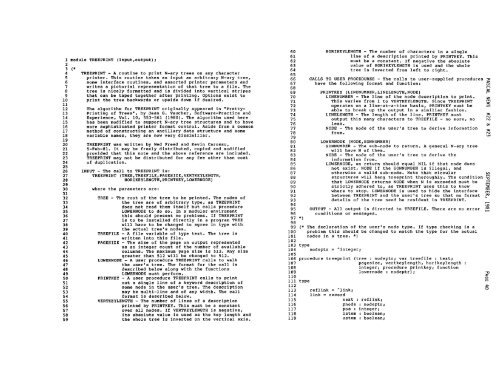Pascal News
Pascal News
Pascal News
Create successful ePaper yourself
Turn your PDF publications into a flip-book with our unique Google optimized e-Paper software.
1 module TREEPRINT (input,output);<br />
2<br />
3 (*<br />
4 TREEPRINT -<br />
5<br />
6<br />
7<br />
8<br />
9<br />
10<br />
11<br />
12<br />
13<br />
14<br />
15<br />
16<br />
17<br />
18<br />
19<br />
20<br />
21<br />
22<br />
23<br />
24<br />
25<br />
26<br />
27<br />
28<br />
29<br />
INPUT - The call to TREEPRINT is:<br />
30 where the parameters are:<br />
31<br />
32<br />
TREE -<br />
33<br />
34<br />
35<br />
36<br />
37<br />
38<br />
39<br />
40<br />
TREEFILE -<br />
41<br />
42<br />
PAGESIZE -<br />
43<br />
44<br />
45<br />
46<br />
LOWERNODE -<br />
47<br />
48<br />
49<br />
50<br />
PRINTKEY -<br />
51<br />
52<br />
53<br />
54<br />
55<br />
VERTKEYLENGTH -<br />
56<br />
57<br />
58<br />
59<br />
A routine to print N-ary trees on any character<br />
printer. This routine takes as input an arbitrary N-ary tree,<br />
some interface routines, and assorted printer parameters and<br />
writes a pictorial representation of that tree to a file. The<br />
tree is nicely formatted and is divided into vertical stripes<br />
that can be taped together after printing. Options exist to<br />
print the tree backwards or upside down if desired.<br />
The algorithm for TREEPRINT originally appeared in ·Pretty<br />
Printing of Trees', by Jean G. Vaucher, Software-Practice and<br />
Experience, Vol. 10, 553-561 (1980). The algorithm used here<br />
has been modified to support N-ary tree structures and to have<br />
more sophisticated printer format control. Aside from a common<br />
method of constructing an ancillary data structure and some<br />
variable names, they are now very dissimiliar.<br />
TREEPRINT was written by Ned Freed and Kevin Carosso,<br />
5-Feb-81. It may be freely distributed, copied and modified<br />
provided that this note and the above reference are included.<br />
TREEPRINT may not be distributed for any fee other than cost<br />
of duplication.<br />
TREEPRINT (TREE,TREEFILE,PAGESIZE,VERTKEYLENGTH,<br />
HORIKEYLENGTH,PRINTKEY,LOWERNODE)<br />
The root of the tree to be printed. The nodes of<br />
the tree are of arbitrary type, as TREEPRINT<br />
does not read them itself but calls procedure<br />
LOWERNODE to do so. In a modular enviroment<br />
this should present no problems. If TREEPRINT<br />
is to be installed directly in a program TREE<br />
will have to be changed to agree in type with<br />
the actual tree's nodes.<br />
A file variable of type text. The tree is<br />
written into this file.<br />
The size of the page on output represented<br />
as an integer count of the number of available<br />
columns. The maximum page size is 512. Any size<br />
greater than 512 will be changed to 512.<br />
A user procedure TREEPRINT calls to walk<br />
the user's tree. The format for the call is<br />
described below along with the functions<br />
LOWERNODE must perform.<br />
A user procedure TREEPRINT calls to print<br />
out a single line of a keyword description of<br />
some node in the user's tree. The description<br />
may be mUlti-line and of any width. The call<br />
format is described below.<br />
The number of lines of a description<br />
printed by PRINTKEY. This must bea constant<br />
over all nodes. If VERTKEYLENGTH is negative,<br />
its absolute value is used as the key length and<br />
the whole tree is inverted on the vertical axis.<br />
60<br />
61<br />
62<br />
63<br />
64<br />
65<br />
66<br />
67<br />
68<br />
69<br />
70<br />
71<br />
72<br />
73<br />
74<br />
75<br />
76<br />
77<br />
78<br />
79<br />
80<br />
81<br />
82<br />
83<br />
84<br />
85<br />
86<br />
87<br />
88<br />
89<br />
90<br />
91<br />
92<br />
93<br />
94<br />
95<br />
96<br />
97 *)<br />
98<br />
HORIKEYLENGTH - The number of characters in a single<br />
line of a description printed by PRINTKEY. This<br />
must be a constant. If negative the absolute<br />
value of HORIKEYLENGTH is used and the whole<br />
tree is inverted from left to right.<br />
CALLS TO USER PROCEDURES - The calls to user-supplied procedures ~<br />
have the following format and function: ~<br />
PRINTKEY (LINENUMBER,LINELENGTH,NODE)<br />
LINENUMBER - The line of the node description to print.<br />
This varies from 1 to VERTKEYLENGTH. Since TREEPRINT<br />
operates on a line-at-a-time basis, PRINTKEY must be<br />
able to break up the output in a similiar fashion.<br />
LINELENGTH - The length of the line. PRINTKEY must<br />
output this many characters to TREEFILE - no more, no<br />
less.<br />
NODE - The node of the user's tree to derive information<br />
from.<br />
LOWERNODE (NODE,SONNUMBER)<br />
SONNUMBER - The sub-node to return. A general N-ary tree<br />
will have N of them.<br />
NODE - The node of the user's tree to derive the<br />
information from.<br />
LOWERNODE, on return should equal NIL if that node does<br />
not exist, NODE if the SONNUMBER is illegal, and<br />
otherwise a valid sub-node. Note that circular ~<br />
structures will hang treeprint thoroughly. The condition"<br />
that LOWERNODE returns NODE when N is exceeded must be ~<br />
strictly adhered to, as TREEPRINT uses this to know ~<br />
where to stop. LOWERNODE is used to hide the interface rn<br />
between TREEPRINT and the user's tree so that no format :c<br />
details of the tree need be resident in TREEPRINT.<br />
......<br />

















